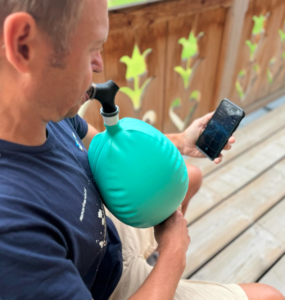Want to relieve your hiccups? We have got you covered! We have developed an amazing protocol that will stop your hiccups in their tracks.

Hiccups, those involuntary contractions of the diaphragm followed by a sudden closure of the vocal cords, can be both a nuisance and a mystery. They often strike without warning and can persist despite our best efforts to banish them. While the exact mechanism behind hiccups is still not fully understood, they are thought to involve a complex interplay between the diaphragm, the vagus nerve, and the phrenic nerve. Fortunately, a novel approach using the Isocapnic Breathe Way Better (BWB) shows promise in stopping hiccups by targeting these very pathways.
Understanding the Diaphragm’s Role
At the core of this Isocapnic Respiratory Training technique is the diaphragm, a large, dome-shaped muscle located at the base of the lungs. The diaphragm plays a crucial role in breathing, contracting and flattening out during inhalation to create a vacuum that draws air into the lungs. To use the BWB, it is essential to focus on utilizing the full range of motion of the diaphragm.
When we experience hiccups, it is often due to an irritation of the nerves that control the diaphragm, leading to its erratic and involuntary contractions. By practicing with the BWB, individuals can engage the diaphragm more fully, ensuring it moves through its complete range of motion. This deliberate and controlled movement can help reset the neural pathways that have been disrupted, restoring normal function.
The Science Behind Isocapnic Respiratory Training and Neural Pathways

The Isocapnic Respiratory Training System involves controlled breathing exercises designed to stabilize and optimize the breathing pattern. By focusing on slow, deep breaths, the diaphragm is encouraged to move smoothly and rhythmically. This practice not only strengthens the diaphragm but also helps recalibrate the neural circuits involved in breathing.
The neural pathways responsible for hiccups involve the phrenic and vagus nerves. These nerves can become hyperexcitable due to various triggers such as sudden temperature changes, excitement, or even certain foods. The BWB technique helps to calm these nerves by promoting regular and controlled diaphramatic movement, reducing the likelihood of the spasmodic contractions characteristic of hiccups.
Inducing a Slight Hypercapnic State
Another convenient component of using the BWB in this way, is the controlled induction of a slight hypercapnic state—a condition where there is a higher-than-normal level of carbon dioxide (CO2) in the blood. While this might sound alarming, it is actually a therapeutic approach used in various respiratory therapies.
During this type of Isocapnic exercise, the goal is to challenge different breathing volumes and frequencies, while precisely controlling the bodies CO2 levels. When we induce an increased level of CO2, we can help reset the body’s respiratory center, located in the brainstem, which is responsible for controlling breathing patterns. Elevated CO2 levels can trigger a series of physiological responses that promote relaxation of the diaphragm and other respiratory muscles, aiding in the cessation of hiccups.
The Potential of BWB for Hiccup Relief
The combination of utilizing the full range of diaphramatic motion and inducing a slight hypercapnic state positions this Isocapnic technique as a potent method for stopping hiccups. By actively engaging the diaphragm through controlled breathing exercises, individuals can effectively interrupt the erratic neural signals causing the hiccups. Moreover, the slight increase in CO2 levels acts as a reset mechanism for the respiratory center, further stabilizing breathing patterns.
Practicing this Isocapnic technique can be a straightforward and accessible way to address hiccups. It involves starting with faster breaths and slowly slowing down the breaths while trying to breathe deeper and smoother, ensuring full engagement of the diaphragm, and incorporating brief bouts of controlled hypercapnia. This method can be particularly beneficial for those who experience frequent or prolonged hiccups, offering a non-invasive and drug-free solution.
Hiccups, while often harmless, can be an annoying disruption. The Isocapnic Respiratory Training System offers a promising solution by leveraging the full range of motion of the diaphragm and inducing a controlled hypercapnic state to reset the neural pathways involved in hiccups. By incorporating the Isocapnic BWB into their routine, individuals may find a reliable method to stop hiccups and regain control over their breathing patterns. As more people explore and validate this technique, it could become a go-to remedy for hiccup relief, combining simplicity with physiological insight for effective results.



